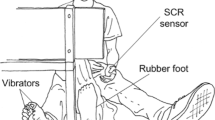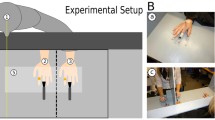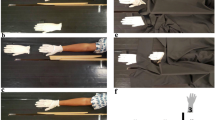Abstract
The “rubber hand illusion (RHI)” is a perceptual illusion, which allows the integration of artificial limbs into the body representation of a person by means of combined visual and tactile stimulation. The illusion has been frequently replicated but always concerning the upper limbs. The present study verified an analog illusion that can be called the “rubber foot illusion” (RFI). In a conjoint experiment using both a rubber hand and a rubber foot, brushstrokes were applied to the respective real and rubber limb placed alongside the real one. However, only the artificial limb’s handling was visible. The brushstrokes were given either synchronously, with a delay of ±0.5 s, or without tactile stimulation of the real limb. Questionnaire data and the proprioceptive drift towards the rubber limb (determined by calling on the subjects to show where they locate their unseen limb) defined the illusion strength. Results revealed that the illusion was induced in both limbs with comparable strength, but only in the synchronous condition.



Similar content being viewed by others
References
Albrecht, M. A., Martin-Iverson, M. T., Price, G., Lee, J., Iyyalol, R., & Waters, F. (2011). Dexamphetamine effects on separate constructs in the rubber hand illusion test. Psychopharmacology (Berl), 217(1), 39–50.
Beckerle, P. (2014). Human-machine-centred design and actuation of lower limb prosthetic systems. Aachen, Germany: Shaker Verlag GmbH.
Botvinick, M., & Cohen, J. (1998). Rubber hands ‘feel’ touch that eyes see. Nature, 391(6669), 756.
Bruno, N., & Bertamini, M. (2010). Haptic perception after a change in hand size. Neuropsychologia, 48(6), 1853–1856.
Ehrsson, H. H., Holmes, N. P., & Passingham, R. E. (2005). Touching a rubber hand: feeling of body ownership is associated with activity in multisensory brain areas. Journal of Neuroscience, 25(45), 10564–10573.
Ehrsson, H. H., Spence, C., & Passingham, R. E. (2004). That’s my hand! Activity in premotor cortex reflects feeling of ownership of a limb. Science, 305(5685), 875–877.
Hajnal, A., Fonseca, S., Harrison, S., Kinsella-Shaw, J., & Carello, C. (2007). Comparison of dynamic (effortful) touch by hand and foot. Journal of Motor Behaviour, 39(2), 82–88.
Heed, T., Grundler, M., Rinkleib, J., Rudzik, F. H., Collins, T., Cooke, E., et al. (2011). Visual information and rubber hand embodiment differentially affect reach-to-grasp actions. Acta Psychologica, 138(1), 263–271.
Holle, H., McLatchie, N., Maurer, S., & Ward, J. (2011). Proprioceptive drift without illusions of ownership for rotated hands in the “rubber hand illusion” paradigm. Cognitive Neuroscience, 2(3–4), 171–178.
Holmes, N. P., Snijders, H. J., & Spence, C. (2006). Reaching with alien limbs: visual exposure to prosthetic hands in a mirror biases proprioception without accompanying illusions of ownership. Perception and Psychophysics, 68(4), 685–701.
Holmes, N. P., & Spence, C. (2006). Beyond the Body Schema: Visual, Prosthetic, and Technological Contributions to Bodily Perception and Awareness. In G. Knoblich, I. M. Thornton, M. Grosjean, & M. Shiffrar (Eds.), Human body perception from the inside out: Advances in visual cognition. Advances in visual cognition. (pp. 15-64). New York, US: Oxford University Press.
Kammers, M. P., de Vignemont, F., Verhagen, L., & Dijkerman, H. C. (2009). The rubber hand illusion in action. Neuropsychologia, 47(1), 204–211.
Lenggenhager, B., Tadi, T., Metzinger, T., & Blanke, O. (2007). Video ergo sum: manipulating bodily self-consciousness. Science, 317(5841), 1096–1099.
Lloyd, D. M. (2007). Spatial limits on referred touch to an alien limb may reflect boundaries of visuo-tactile peripersonal space surrounding the hand. Brain and Cognition, 64(1), 104–109.
Longo, M. R., Schuur, F., Kammers, M. P., Tsakiris, M., & Haggard, P. (2008). What is embodiment? A psychometric approach. Cognition, 107(3), 978–998.
Makin, T. R., Holmes, N. P., & Ehrsson, H. H. (2008). On the other hand: dummy hands and peripersonal space. Behavioural Brain Research, 191(1), 1–10.
Marasco, P. D., Kim, K., Colgate, J. E., Peshkin, M. A., & Kuiken, T. A. (2011). Robotic touch shifts perception of embodiment to a prosthesis in targeted reinnervation amputees. Brain, 134(Pt 3), 747–758.
Paladino, M. P., Mazzurega, M., Pavani, F., & Schubert, T. W. (2010). Synchronous multisensory stimulation blurs self-other boundaries. Psychological Science, 21(9), 1202–1207.
Penfield, W., & Rasmussen, T. (1950). The Cerebral cortex of man: a clinical study of localization of function. New York: Macmillan.
Ramachandran, V. S., Krause, B., & Case, L. K. (2011). The phantom head. Perception, 40(3), 367–370.
Ramakonar, H., Franz, E. A., & Lind, C. R. (2011). The rubber hand illusion and its application to clinical neuroscience. Journal of Clinical Neuroscience, 18(12), 1596–1601.
Rohde, M., Di Luca, M., & Ernst, M. O. (2011). The Rubber Hand Illusion: feeling of Ownership and Proprioceptive Drift Do Not Go Hand in Hand. PLoS ONE, 6(6), e21659.
Rosen, B., Ehrsson, H. H., Antfolk, C., Cipriani, C., Sebelius, F., & Lundborg, G. (2009). Referral of sensation to an advanced humanoid robotic hand prosthesis. Scandinavian Journal of Plastic and Reconstructive Surgery and Hand Surgery, 43(5), 260–266.
Schicke, T., Bauer, F., & Roder, B. (2009). Interactions of different body parts in peripersonal space: how vision of the foot influences tactile perception at the hand. Experimental Brain Research, 192(4), 703–715.
Shimada, S., Fukuda, K., & Hiraki, K. (2009). Rubber hand illusion under delayed visual feedback. PLoS One, 4(7), e6185.
Tsakiris, M., Carpenter, L., James, D., & Fotopoulou, A. (2010). Hands only illusion: multisensory integration elicits sense of ownership for body parts but not for non-corporeal objects. Experimental Brain Research, 204(3), 343–352.
Tsakiris, M., & Haggard, P. (2005). The rubber hand illusion revisited: visuotactile integration and self-attribution. Journal of Experimental Psychology: Human Perception and Performance, 31(1), 80–91.
Tsakiris, M., Hesse, M. D., Boy, C., Haggard, P., & Fink, G. R. (2007). Neural signatures of body ownership: a sensory network for bodily self-consciousness. Cerebral Cortex, 17(10), 45.
van Beers, R. J., Sittig, A. C., & Denier van der Gon, J. J. (1998). The precision of proprioceptive position sense. Experimental Brain Research, 122(4), 367–377.
van Beers, R. J., Wolpert, D. M., & Haggard, P. (2002). When Feeling Is More Important Than Seeing in Sensorimotor Adaptation. Current Biology, 12, 834–837.
van Elk, M., Forget, J., & Blanke, O. (2013). The effect of limb crossing and limb congruency on multisensory integration in peripersonal space for the upper and lower extremities. Consciousness and Cognition, 22(2), 545–555.
Weber, E. H. (1846). Der Tastsinn und das Gemeingefühl. In R. Wagner (Ed.), Handwörterbuch der Physiologie. Braunschweig: Vieweg.
Welch, R. B., & Warren, D. H. (1986). Intersensory Interaction. In L. Kaufman, & J. P. Thomas (Eds.), Handbook of Perception and Human Performance New York: Wiley-Interscience.
Acknowledgments
Special thanks to Manfred Häfke at Technische Universität Darmstadt, who built the apparatus to elicit the RHI and RFI.
Author information
Authors and Affiliations
Corresponding author
Rights and permissions
About this article
Cite this article
Flögel, M., Kalveram, K.T., Christ, O. et al. Application of the rubber hand illusion paradigm: comparison between upper and lower limbs. Psychological Research 80, 298–306 (2016). https://doi.org/10.1007/s00426-015-0650-4
Received:
Accepted:
Published:
Issue Date:
DOI: https://doi.org/10.1007/s00426-015-0650-4




